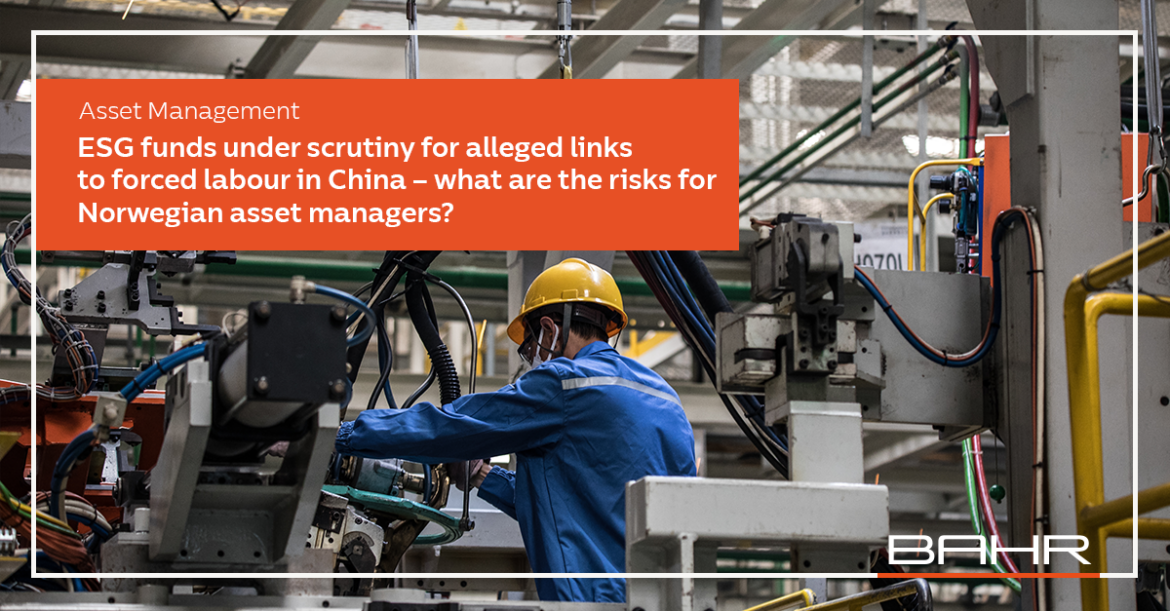Asset Management | ESG funds under scrutiny for alleged links to forced labour in China – what are the risks for Norwegian asset managers?

Background
Global ESG funds have invested $789 million in Contemporary Amperex Technology (CATL), the world’s largest manufacturer of EV and energy storage batteries. Among the investors are BlackRock, Nordea, and Ninety One, whose combined investment exceeds $300 million. CATL, along with other companies, is currently facing allegations of being connected to state-sponsored forced labor and human rights abuses against the Xinjiang minority. This situation exemplifies the challenges faced by companies with complex supply chains. The recent decision by the U.S. Department of Defense to “blacklist” CATL and other companies due to these allegations is discussed in an article in Dagens Næringsliv on January 8, 2025.
In 2020, the US, followed by the EU, imposed sanctions on the Xinjiang Production and Construction Corps and several Chinese officials due to human rights allegations. The US Uyghur Forced Labor Prevention Act (UFLPA) of 2021 established a rebuttable presumption that goods from Xinjiang or entities on the UFLPA Entity List are produced with forced labour, prohibiting import unless clear evidence proved otherwise. The EU Forced Labour Regulation, adopted on November 19 and published on December 12, 2024, will prohibit placing and making available on the Union market, and to export from the Union market, any product made using forced labour from the end of 2027. The ban will affect all products regardless of origin or industry. Future policies against China may be influenced by the new US administration.
While the risk of forced or child labour is not confined to the renewable energy sector or to China geographically, many companies, including Norwegian, have faced significant challenges in sourcing critical raw materials and components, such as those for solar panels, due to limited transparency. In response to the coordinated Western sanctions, China imposed countersanctions, effectively hindering transparency and increasing challenges for companies operating in or sourcing from China.
Implications for Norwegian asset managers
Since July 2022, the Norwegian Transparency Act (Nw: Åpenhetsloven) (the Act) has required fund managers and their portfolio investments (meeting certain thresholds) to conduct risk-based due diligence to identify and manage risks related to human rights and decent working conditions. Eliminating gross human rights violations, such as forced and child labour, is a primary objective of the Act. Portfolio investments with suppliers based in or linked to China should inherently be considered higher risk, and asset managers with such exposures should ensure that companies adequately address these risks. Failing to perform proper due diligence (Nw.: aktsomhetsvurderinger), and failing to act on potential risks, may lead to legal liability.
Additionally, many asset managers are obligated to ensure that funds are not invested in or linked to forced and/or child labour through side letters or similar contractual obligations creating separate responsibilities towards investors beyond regulatory requirements.
BAHR Comments
Companies like CATL exemplify the challenges with “ESG investing”. While investments in such companies may be environmentally beneficial due to contributions to reducing greenhouse gas emissions, they may be at risk of being linked to human rights violations.
The revelations about ESG funds’ investments in companies potentially linked to forced labour in Xinjiang underscore the need for rigorous due diligence and ongoing monitoring of portfolio investments throughout the investment cycle:
- At entry: A risk based due diligence on forced and child labour, including in the target company’s supply chain, should be integrated into pre-acquisition M&A due diligence processes. Specific risk areas such as goods and suppliers should be classified, and targeted reviews should be performed where the risk is considered high. This approach helps in understanding and mitigating risks. A plan for post-closing integration established before signing helps understanding the resources required post-closing to adequately reduce risk, which may be considered into pricing.
- During ownership: The due diligence should continue post-closing where necessary (e.g. where relevant information was not available prior to closing). Operative activities to further reduce risk can be implemented, such as training, audits and potentially also termination of supplier contracts if risks cannot be mitigated. The integration plan can transition into a long-term, risk-based monitoring process, ensuring that risks are adequately reduced at the portfolio level.
- Preparing for exit: At this stage potential showstoppers linked to risk of forced and child labour should be identified and managed through pre-exit due diligence. If risks have been addressed during pre-acquisition due diligence and effectively monitored during ownership, additional due diligence at this stage may not be required, or it may be sufficient with a limited review only.
